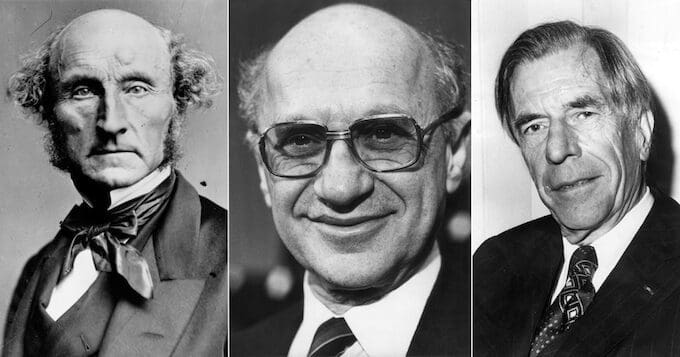Is socialism on the march in the U.S., as President Donald Trump warned in the State of the Union address this month? Hardly, but some recent proposals undoubtedly raised the prospect of a sharp lurch to the left, most notably the growing enthusiasm among Democrats for a guaranteed cash payment to all members of society.
At first glance, the idea of a universal basic income, or UBI, reeks of pie-in-the-sky idealism. Nonetheless, it’s been gaining traction among U.S. progressives, even popping up in the recent discussions about a Green New Deal. In addition, it is part of the conversation in several countries, including India, and has already had a trial run in Finland, a country well known for its elaborate social safety net.
But the idea of handing out an equal lump sum of free money to all with no strings attached isn’t just a pet project of woolly-headed leftists. Since the late 18th century, UBI hasn’t been seen as a form of welfare so much as a way to get rid of welfare entirely. That may explain why it has attracted such an eclectic group of supporters over the centuries — and may account for its renaissance today.
The UBI is premised on the idea that every member of society is entitled to cash payments that will enable them to subsist. The key here is subsistence: Most proposals emphasize that the payment should be minimal, so small, in fact, that it would be an incentive for the poorest recipients to seek work. Thomas Paine, the Founding Father and all-around 18th-century revolutionary, was among the first to propose some version of the idea, arguing that the amount should be sufficient for a young couple to “buy a cow, and implements to cultivate a few acres of land.”
Writing a few decades after Paine, the radical Belgian thinker Joseph Charlier outlined a national version of the UBI. He assured his critics that the size of the payment would be quite modest. “The state will secure bread to all but truffles to no one,” he wrote. “Too bad for the lazy; they will have to get by with the minimum allowance. The duty of society does not go beyond this.”
Charlier’s idea failed to gain admirers. But the British philosopher John Stuart Mill had more luck persuading readers. In Mill’s time, poverty was handled in one of two ways: private charity or compulsory labor in so-called workhouses. In both cases, this required judgments — often subjective — about whether the person was worthy of charity or should be forced to work.
Mill wanted to get rid of both approaches. “The dispensers of public relief have no business to be inquisitors,” he wrote. Instead, he proposed that everyone be guaranteed a subsistence income, but nothing more. He wished to insure “all persons against absolute want,” but this minimum subsistence income had to be made “less desirable than the condition of those who find support for themselves.”
Although proponents of the idea in the 20th century, including members of the British Labour Party, were unapologetic statists, the same could not be said of another convert to the UBI idea: the libertarian economist Friedrich Hayek. Like his predecessors, the Nobel laureate believed the UBI should be a bare minimum; anything more would require “controlling or abolishing the market.”
Hayek argued that “the assurance of a certain minimum income for everyone, or a sort of floor below which anybody need fall even when he is unable to provide for himself” was “wholly legitimate” and a “necessary” condition of modern life. But Hayek did not offer an institutional blueprint for making this happen.
The University of Chicago economist Milton Friedman did. Like Hayek, he despised government welfare programs, which attacked poverty via an elaborate patchwork quilt of food stamps, housing subsidies, and other need-based measures. Friedman wanted to sweep away all of this, replacing it with something he called a “negative income tax.”
The way it worked was simple: Taxpayers unwilling or unable to work got a rebate that was enough to permit them to subsist — barely. Friedman believed the level had to be “low enough to give people a substantial and consistent incentive to earn their way out of the program.” All other public assistance would be abolished.
Other advocates for a universal basic income in the 1960s and 1970s had different ideological sympathies, but more than a few agreed that the welfare system was broken. The economist John Kenneth Galbraith, writing in 1966, argued for a “minimum income.” Anticipating the claim that it would “destroy incentives” to work, he retorted: “Yet we now have a welfare system that could not be better designed to destroy incentive if we wanted it that way. We give the needy income, and we take away that income if the recipient gets even the poorest job.”
Far better, argued Galbraith, to put a uniform, universal floor below which no one could fall, and let those with the will to work supplement this basic income with the fruits of their labor. A thousand economists petitioned Congress to consider the idea in 1968; President Lyndon Johnson’s Commission on Income Maintenance Programs offered additional support for the proposal in 1969.
The Commission proposed to do away with the existing welfare system, replacing it a “basic income support program” that used Friedman’s negative income tax. This wasn’t welfare, but it wasn’t workfare, either. “We do not think it desirable,” the report concluded “to put the power of determining whether an individual should work in the hands of a Government agency when it can be left to individual choices and market incentives.”
billionaires from Silicon Valley. This is paralleled by enthusiasm overseas, most notably in India and, of course, Finland (though a two-year experiment there ended in December and showed mixed early results).
Perhaps there’s room for a grand compromise of the kind envisioned by Mill, Friedman, Galbraith and others: a universal basic income that brings the end of traditional welfare programs. But if UBI becomes yet another hybrid of welfare and workfare, history suggests it’s doomed to fail.






















